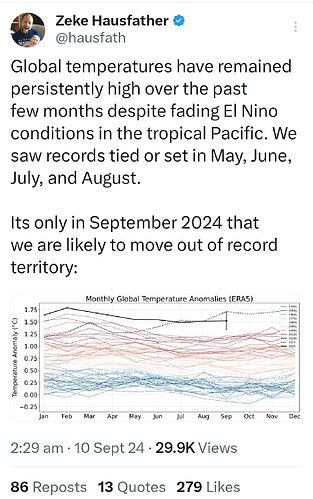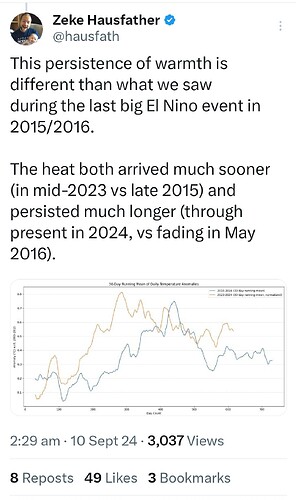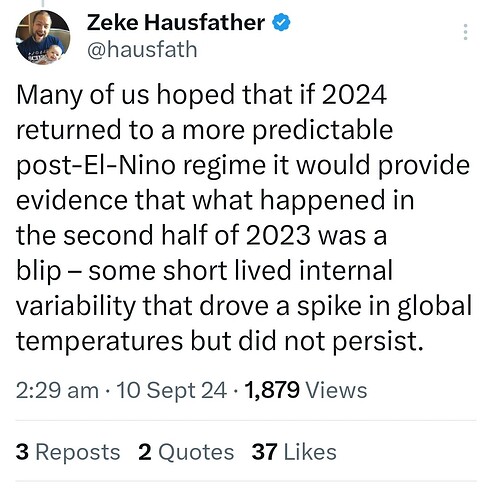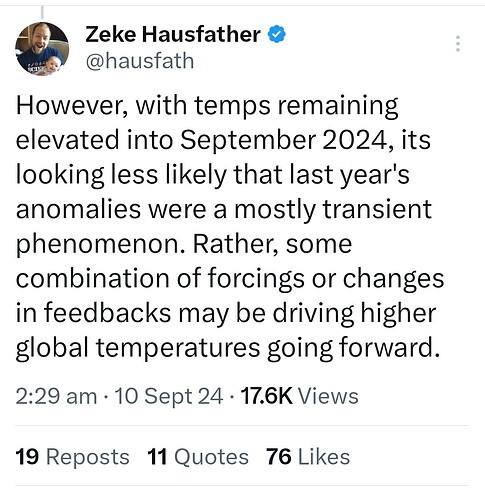An unenforceable, toothless agreement that will ultimately do nothing? Probably nothing more than some hand wringing.
Anyway, it already is a crime and the punishment is the destruction of the natural world. Although unwritten, nature has laws too.
Yeah, I found it interesting, but not sure how it could ever work practically.
Nothing will ever happen whilst those that should be prosecuted have the politicians in their pocket. Banning political donations is one way forward, til then, they will keep exploiting our planet when there is money to be made.
The sun is currently @ peak solar maximum … perhaps that is a contributor. Remember those funny lights in the night in May. Also the Tonga volcano & the water vapor that was injected into the atmosphere.
Solar maximum is an interesting one. From the looks of it, you’re only going to get a 0.1C bump at the top of the cycle. So it’s something, but it doesn’t explain why this particular cycle is the hottest on record, higher than all the other cycles we have experienced.
The Tonga volcano is likely having an impact, but is modelled to cause a maximum of 0.035C of warming. Something, but probably not enough to push us into global record temperatures. We’ve had volcanoes fairly regularly over the centuries, Tonga isn’t exceptionally unusual compared to events we’ve experienced in the past.
So yeah, I think there’s short term factors that are nudging the results a tad, but at best they explain a 10 year peak rather than a recorded history peak.
If solar maximum had an impact you would see atmospheric heating at higher altitudes. We don’t see that we see atmospheric cooling so solar maximum isn’t responsible.
That makes it very clear that we need to limit population growth.
Or for humans to limit their individual contributions to emissions , including methane emissions.
The Mayor of Paris has recently decided to lower the speed limit on the ring road from 70 to 50 with a view to lowering emissions. This is being strongly opposed.
People hate being inconvenienced, even if it is for the greater good.
This was a fascinating chat with Prof. Corey Bradshaw from Flinders Uni. His solutions were not something I had ever thought about.
I reckon Australia could take the lead in in grid scale batteries.
SA hit 73% sourced from green energy recently, they will be at 100% soon.
I recall reading somewhere Vic are building a battery farm as well.
Charging forward
Clean energy’s next trillion-dollar business
Grid-scale batteries are taking off at last

Illustration: Rose Wong
Sep 1st 2024
Decarbonising the world’s electricity supply will take more than solar panels and wind turbines, which rely on sunshine and a steady breeze to generate power. Grid-scale storage offers a solution to this intermittency problem, but there is too little of it about. The International Energy Agency (IEA), an official forecaster, reckons that the global installed capacity of battery storage will need to rise from less than 200 gigawatts (GW) last year to more than a terawatt (TW) by the end of the decade, and nearly 5TW by 2050, if the world is to reach net-zero emissions (see chart 1 ). Fortunately, though, the business of storing energy on the grid is at last being turbocharged.

Chart: The Economist
Grid-scale storage traditionally relied on hydroelectric systems that moved water between reservoirs at the top and bottom of a slope. These days giant batteries stacked in rows of sheds are increasingly the method of choice. According to the IEA, 90GW of battery storage was installed globally last year, double the amount in 2022, of which roughly two-thirds was for the grid and the remainder for other applications such as residential solar. Prices are falling and new chemistries are being developed. Bain, a consultancy, estimates that the market for grid-scale storage could expand from around $15bn in 2023 to between $200bn and $700bn by 2030, and $1trn-3trn by 2040.
A plunge in the price of lithium batteries is fuelling their adoption on the grid. According to BloombergNEF, a research group, the average price of stationary lithium batteries per kilowatt-hour of storage fell by around 40% between 2019 and 2023. A global deceleration in the adoption of electric vehicles (EVs), which run on similar technology, has led battery manufacturers to take a keener interest in grid storage. In 2019 stationary lithium batteries were almost 50% more expensive than those used in EVs; that difference has fallen to less than 20% as producers have piled in (see chart 2). The IEA reckons that solar power combined with batteries is now competitive with coal-fired electricity in India, and is on track to be cheaper than gas-fired power in America in a few years.

Chart: The Economist
The centre of global battery production is China. It is home to four of the world’s five biggest manufacturers, including CATL and BYD (see chart 3). The share of China’s battery production destined for stationary storage has risen from almost nothing in 2020 to around a fifth last year, overtaking the share used in consumer electronics. Growth has been helped by policies at home mandating that big solar and wind projects also install storage.
China’s battery firms are intensely innovative. CATL, for example, has increased its investment in research and development eight-fold since 2018, to $2.5bn last year. BYD, which has invested heavily in robotics and artificial intelligence, has built a battery facility in the Chinese city of Hefei that is almost entirely automated. But the industry is also swimming in overcapacity. According to BloombergNEF, China already produces enough lithium batteries to satisfy global demand of all types. Its industry has announced plans for a further 5.8 terawatt-hours (TWh) of capacity by 2025, more than double the current global capacity of 2.6TWh.
That will be catastrophic for many firms in the battery industry, including those producing for the grid. According to Benchmark Mineral Intelligence, another research outfit, construction on 19 battery gigafactories in China was cancelled or postponed in the first seven months of 2024. The collapse in prices has also pummelled many Western battery startups. One example is Sweden’s Northvolt, seen by some as Europe’s answer to China’s champions. Last year it reported a loss of $1.2bn, up from $285m in 2022. The consequence of all this is likely to be a wave of consolidation, as Robin Zeng, the boss of CATL, predicted earlier this year.

Chart: The Economist
Even so, a bloodbath among battery-makers could help, rather than hurt, the adoption of battery storage. Prices could fall further as the most productive companies take a greater share of the market. Fierce competition is already spurring innovation, as companies seek out new technologies to help them compete. Sodium-ion batteries are one promising alternative. They do not require pricey lithium, and although they offer lower energy density, that is less of a problem for stationary batteries than for those powering EVs.
Incumbents are rushing to develop the technology for the grid. Several startups are betting big on it, too. Natron, an American firm backed by Chevron, an oil giant, is investing $1.4bn to build a sodium-ion battery factory in North Carolina, which is scheduled to open in 2027. Landon Mossburg, the chief executive of Peak Energy, a sodium-ion startup, says he wants his firm to be “the CATL of America”.
Tom Jensen, the boss of Freyr Battery, another startup, thinks the only way that Western battery companies will be able to compete is with new technologies. The list of innovative approaches is growing. EnerVenue, one more startup, is commercialising a nickel-hydrogen battery. The firm has raised over $400m and will build a plant in Kentucky that it hopes will crank out cheap batteries that can store power for long periods.
Power up
It helps that these new technologies are well-suited to meeting the growing demand for energy from data centres, which tech giants are eager to run on renewable power. The fact that sodium-ion batteries are less prone to catching fire than lithium-based ones makes them particularly attractive for tech companies, not least because it lowers the cost of insurance, notes Jeff Chamberlain, the boss of Volta Energy Technologies, an investment firm focused on the energy-storage business. Colin Wessels, the co-chief of Natron, notes that his startup plans to supply batteries largely to data centres.
The rapid rollout of data centres is also leading to gaps in the grid infrastructure needed to produce and transmit power, which longer-duration batteries like EnerVenue’s could help plug. Aaron Zubaty, the boss of Eolian, a renewable-energy developer, predicts a boom in storage solutions of four to eight hours to cope with the growing demand on power grids over the coming decade.
Grid-scale storage, then, is advancing quickly. “Batteries have done in five years what took solar 15 years,” notes a veteran analyst of the solar boom, who now covers the industry. As Fatih Birol, the head of the IEA, sums up, “Batteries are changing the game before our eyes.” ■
Waaaaaait a minute…
But the storm still raised alarm for some on the Gulf. Before it hit, Francine fed off the unusually warm waters of the Gulf and rapidly developed into a category 2 storm. That was a surprise – but one that is becoming more common, scientists say, as global climate change is causing sea temperatures to rise. For many residents, their relief was also tinged with fear – Francine had hit harder than many expected and that might be a sign of the future.
Francine’s winds reached 100mph (160km/h), as it tore through many of the same bayous and towns that were rocked by Hurricane Ida in 2021, which displaced thousands on Louisiana’s fragile and rapidly disappearing coast.
Rough sums of battery capacity that I can find that is constructed or under construction on the east coast. QLD, NSW, VIC, SA and TAS.
Today
19 batteries making 1832MW storing 2826MWh
End 2025
36 batteries making 6916MW storing 14216MWh
End 2026
47 batteries making 9100MW storing 22638MWh
End 2027
52 batteries making 10215MW storing 26168MWh
The tail off isn’t due to lack of projects, but lack of locked in details. There are an additional 100 battery projects announced or proposed that I can’t be bothered adding up, but the 2027 capacity is likely to increase by at least 50% from this forecast.
In addition, we have pumped hydro
Today
3 dams making 2610MW storing many MWh
2025
4 dams making 2860MW storing many many MWh
2028
5 dams making 4860MW storing lots MWh
The Tasmania battery of the nation project aims to bring and additional 4800MW of PHES to the east coast market. That will be constrained by undersea cables, so likely 2000MW of capacity linked to the mainland grid. There’s also about 18 other small to medium sized PHES projects on the mainland announced or in planning.
So by the end of 2028, I think it’s reasonable that Australia’s east coast market will have about 25GW of batteries and PHES, mostly with 2 hours of storage. That’s for a maximum demand of 60GW and a normal demand around 30-40GW. Considering we have about 4.4GW of storage today, the Australian energy market is about to go through a very transformative period.
What this means is solar farms will become viable again as a floor is placed on the daytime energy price. Batteries will have enough capacity to cover the evening peaks, allowing some coal plants to depart.
Also, I haven’t seen these numbers collated anywhere else, so you can call this one a blitz exclusive.
We have an abundance of gas and coal which has served us well for generations. The smartest thing to do would be to keep using that. We cannot control the weather, particularly not by lowering the minuscule amount of CO2 we do emit, so there is no point building batteries, wind farms or solar paddocks for that purpose. It’s pointless virtue signalling and is devastating the poor. Cheap and reliable power will support industry and jobs, which makes us all rich. Instead of this mad excuse for ‘environmentalism’, we should focus on cleaning up creeks and rivers, and properly managing crown land and national parks so they aren’t wiped out by fire. It is an absolute travesty how that land has been managed here in Victoria for most of the past 25 years. Overgrown and out of control, ready to light up if we get a hot summer, which we will likely see due to the fact that giant nuclear reactor in the sky, that we call the sun, is entering a solar maximum.
Are you genuinely interested in a discussion that may change your mind or are you going to be locked into those very stereotypical right wing information bubble talking points?
Because I’m happy to pull those issues apart with you, but I’m only going to bother if you respect the effort it takes and give it due consideration.
Spoiler: he’s not.





